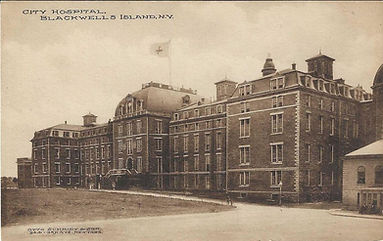A Bridge, a Lighthouse and a Castle:
explorations in history
By Bob Stonehill
I was recently interviewed by John Gill, writer of the New York Times’ bi-weekly article, “Streetscapes,” in the Real Estate Section, about my antique postcard collection. Over decades, I have collected old New York City postcards, both cancelled and not, showing views of every neighborhood in the five boroughs of New York City, displayed in albums by neighborhood. He wanted to know what drove me to search the world for these cards over a 40 year period, starting in 1980. I explained that my father Ben was interested in the city’s history and used to bring home books that inspired my brother and me to venture out on our own to find nuggets of history in our own expanded "backyard." Here is just one of our stories.
When I was about 12 years old, my brother Lee, who was two years older than I, decided to explore Welfare Island, (known as Blackwell’s Island during colonial days, and Roosevelt Island today). From 1909, when the Queensboro Bridge was built until 1916, the only way to gain access to the island was by ferry or a launch from East 87th Street in the Yorkville section of Manhattan.


Before the Queens Plaza based trolley (which we rode over the bridge) was eliminated in 1955, a trolley would make a stop mid span to off load workers. If the trolley was coming from the Manhattan side, it would travel on the southern or downtown side roadway, also stopping mid span. Here, passengers would disembark, and in order to get to the north side elevator building, they would traverse a walkway suspended under the bridge roadway, a scary proposition.
Since the original bridge design encouraged walkers by providing exclusive wide walkways, they had all been eliminated with the growth of vehicular traffic. When the bridge opened in 1909, the support towers on both the Manhattan side and the Queens side provided elevator service from the ground to the walkways, but these elevators had long before been abandoned, and my brother and I carried our bikes up the circular staircase in the tower on the Queens side. Today, this would not be possible as the tower doors have been locked for nearly 60 years.
We made our way along the trolley tracks and reached the mid span upside down elevator building. Once on the ground, we headed south to the long abandoned Small Pox Hospital, found an opening in the chain link fence, and explored the dilapidated building. Today, the fence still surrounds the relic as a preserved ruin. Our first architectural dig uncovered rattan wheel chairs and a dusty entry log book dating back more than 100 years. We placed the book back in the same spot on the floor, as if untouched by time, covered with falling plaster.
We rode around the island to the northern tip where we discovered a 50 foot light house. Built in 1872 by a local, it stands today, renovated and a useful navigational tool. At the base was a plaque, long since removed. It read, "This is the work was done by John McCarty who built the light house from the bottom to the top all ye who do pass by may pray for his soul when he dies.“

On the return trip to Queens, we reversed our steps. All this was before the new Roosevelt Island Bridge from Vernon Avenue made the island easily accessible and spurred its growth. Back on Vernon Avenue, we were right under the bridge, and viewed the New York Terra Cotta Works office building, clearly marked, built in 1892, and still standing fully boarded up then and now.
From there we headed south a few blocks and inside a lumber yard, we saw what today would be described as a vision of our imagination: a cut stone castle with a tower rising above the main building. We entered the yard and knocked on the door. An elderly secretary sat at her desk. We asked if there was access to the tower. She waved her hand, pointing to the staircase with a "suit yourself" look. Halfway up the narrow tower steps, our jackets covered in white dust, we abandoned our climb. The castle discovered and explored, it gave us bragging rights for years afterwards. We’d persist in telling non-believers that the Bodine Castle actually existed.

The John A. Bodine Castle, 43-16 Vernon Boulevard, Long Island City. Photo taken 1933.
Years later, Lee and I drove our two boys around Long Island City. We showed them the stone wall remnants on either side of Vernon Boulevard, evidence of what was a highlight of our youthful adventures, and something historic from times gone by. A few years after our conquest, the lumber yard was sold to Con-Ed; the castle was demolished. Rumor had it that the owner had caught his daughter carrying on with a local workman and chained the young man until neighbors found and freed him. Another rumor spoke of an underground tunnel to the nearby East River used for smuggling. For decades, prior to computers and the internet, I carried around a picture from a local newspaper decrying the demolition of this 1853 castle.
Quite a family, the Stonehills, who still enjoy exploring historic sites!




From upper left clockwise: Blackwell's Island Penitentiary, City Hospital, Female Almshouse, Metropolitan Hospital. Post Cards courtesy Bob Stonehill